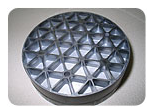UM effectively machines precise features in hard, brittle materials such as glass, engineered ceramics, CVD SiC, quartz, single crystal materials, PCD, ferrite, graphite, glassy carbon, composites and piezoceramics. A nearly limitless number of feature shapes-including round, square and odd-shaped thru-holes and cavities of varying depths, as well as OD-ID features-can be machined with high quality and consistency (see Figure 3). Features ranging in size from 0.008 in. up to several inches are possible in small workpieces, wafers, larger substrates and material blanks. Aspect ratios as high as 25-to-1 are possible, depending on the material type and feature size.
Variations of feature size, shape and cavity depth are typically held to within a tolerance of ± 0.002 in., while tighter tolerances are possible depending on application requirements and process parameters. The machining of parts with preexisting machined features or metallization is possible without affecting the integrity of the preexisting features or surface finish of the workpiece. Locational tolerance of features relative to fiducials or preexisting features is typically held within ± 0.002 in., although tighter tolerances are possible depending on the application.
Figure 4. A UM-machined square hole in 0.0175-in. thick glass. The machined feature exhibits a clean edge, and the natural corner radius is < 0.005 in.
Unlike conventional machining methods, ultrasonic machining produces little or no sub-surface damage and no heat-affected zone. The quality of an ultrasonic cut provides reduced stress and a lower likelihood of fractures that might lead to device or application failure over the life of the product (see Figure 4). UM is particularly well-suited for high-reliability applications where preservation of the critical material properties and avoidance of the introduction of residual stresses from machining processes are vital to the project’s success.
An added benefit is that parts machined ultrasonically often perform better in downstream machining processes than do parts machined using more conventional machining methods. The improved performance can result in economic advantages from higher yields, lower scrap and operating costs, and improved efficiencies.
Honeycomb structure machined on the back of a silicon mirror for NASA.




